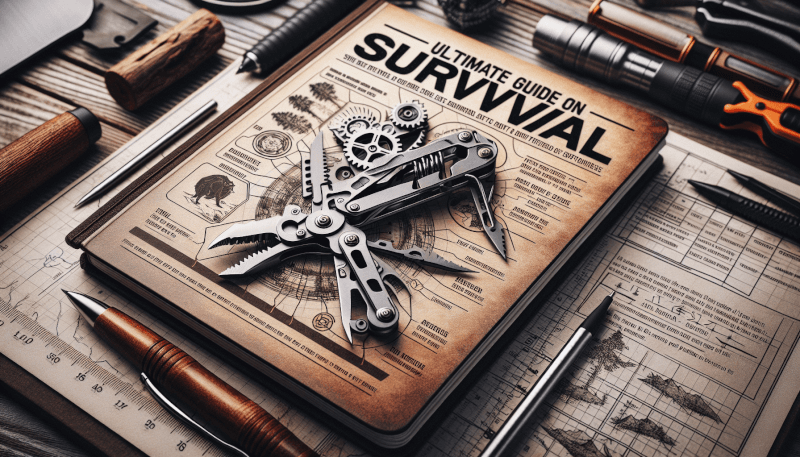Imagine finding yourself in a challenging situation, far away from civilization, with limited resources and knowledge of survival. Don’t worry, SAS Survival Handbook: The Definitive Survival Guide is here to help you navigate those treacherous terrains. Packed with essential tips, techniques, and strategies, this comprehensive guide equips you with the knowledge needed to not only survive but thrive in the most extreme conditions. From shelter-building to foraging for food, this survival compendium is your ultimate companion, providing practical advice and expert wisdom to keep you safe and secure in any wilderness adventure.

Introduction to SAS Survival Handbook
The SAS Survival Handbook is the definitive guide to surviving in various challenging situations. Whether you find yourself in the wilderness, facing a natural disaster, or stuck in an urban environment during a crisis, this book provides you with the essential knowledge and skills to stay alive. Written by John “Lofty” Wiseman, a former British Army soldier and instructor, this comprehensive guide is trusted by survival experts and enthusiasts worldwide. It covers a wide range of topics, from basic survival skills to medical emergencies and psychological resilience.
Basic Survival Skills
Finding and purifying water
Water is the most crucial resource for survival. This section of the book teaches you how to locate water sources in the wild, such as rivers, lakes, and streams. It also explains various methods of purifying water to make it safe for consumption, including boiling, using water filters, and chemical treatments.
Building a shelter
In extreme environments, having a shelter is essential for protection against harsh weather conditions. The SAS Survival Handbook provides guidance on constructing different types of shelters, from simple lean-tos to more elaborate designs. It also teaches you how to choose appropriate shelter locations and how to insulate yourself from the ground to conserve heat.
Starting a fire
Fire is not only a source of warmth but also a means of cooking, purifying water, and signaling for help. This section teaches you different techniques for starting a fire using various materials, including friction-based methods, using flint and steel, and using the sun’s rays. It also emphasizes the importance of fire safety and how to properly extinguish a fire.
Navigating with a compass
Knowing how to navigate accurately can mean the difference between getting lost and reaching safety. The SAS Survival Handbook provides comprehensive instructions on using a compass to determine your direction and navigate through unfamiliar terrain. It covers topics such as reading maps, understanding different types of compasses, and how to use landmarks for orientation.
Signaling for help
In emergency situations, it’s crucial to be able to signal for help and increase your chances of being rescued. This section of the book covers various techniques for signaling, including the use of visual signals such as smoke, mirrors, and flags, as well as auditory signals like whistles and horns. It also discusses how to attract attention from search and rescue teams and aircraft.
Survival Priorities
Understanding the Rule of Threes
The Rule of Threes is a fundamental principle in survival situations. This section explains that humans can survive approximately three minutes without air, three hours without shelter, three days without water, and three weeks without food. It emphasizes the importance of prioritizing your immediate needs based on this rule to increase your chances of survival.
Assessing immediate dangers
In any survival situation, it’s crucial to assess and address immediate dangers to ensure your safety. This section guides you on how to identify hazards such as unstable terrain, wild animals, or imminent threats. It emphasizes the importance of situational awareness and provides tips for avoiding or mitigating potential dangers.
Prioritizing basic needs: food, water, shelter, and heat
Once immediate dangers have been addressed, the SAS Survival Handbook emphasizes the need to prioritize basic needs. This includes securing a clean water source, finding or building a shelter, and ensuring a source of heat for warmth. The importance of conserving energy and focusing on obtaining food is also discussed, including methods of foraging and hunting for sustenance.
Survival Kit Essentials
Choosing the right survival kit
A well-prepared survival kit can be a lifesaver in emergency situations. This section of the book provides guidance on selecting the right survival kit based on your specific needs and environment. It highlights the importance of durability, portability, and versatility in the items included in the kit.
Must-have items in a survival kit
The SAS Survival Handbook outlines essential items that should be included in any survival kit. These include a reliable knife, fire-starting tools, a water container, a compass, waterproof matches, a signaling mirror, a first aid kit, and a multi-tool. The book explains the uses and importance of each item, emphasizing their versatility and ability to meet multiple survival needs.
Personalizing your survival kit
While there are essential items that should be included in every survival kit, personalizing your kit to meet your specific needs is crucial. The SAS Survival Handbook encourages you to consider factors such as your environment, climate, and personal medical needs when selecting additional items for your kit. It provides suggestions for specialty items, such as insect repellent, medications, and specific tools based on different scenarios.

Wilderness Survival
Identifying edible plants
In wilderness survival situations, knowing how to identify edible plants can provide a vital source of food. This section of the SAS Survival Handbook educates readers on identifying and preparing safe-to-eat plants in various environments. It emphasizes the importance of proper plant identification to avoid ingesting poisonous species.
Trapping and hunting for food
In extended survival scenarios, it may be necessary to hunt or trap animals for sustenance. The book covers various trapping techniques, emphasizing ethical considerations and legal restrictions. It also provides guidance on hunting methods, such as tracking, stalking, and using improvised weapons effectively.
Handling wildlife encounters
Encounters with wild animals can be dangerous, and understanding how to handle such situations is crucial for personal safety. This section of the book educates readers on different types of wildlife encountered in various regions and provides tips on how to react appropriately. It emphasizes the importance of avoiding confrontations and adopting defensive measures when necessary.
Avoiding hypothermia and heat exhaustion
Extreme temperatures can pose significant threats to survival. This section of the SAS Survival Handbook discusses prevention and treatment techniques for hypothermia and heat exhaustion. It covers topics such as proper clothing choices, insulation methods, and effective temperature regulation strategies.
Urban Survival
Securing your home
In urban survival scenarios, securing your home is of utmost importance. This section provides practical tips on fortifying your home against intruders, including securing doors and windows, reinforcing locks, and creating barriers. It also emphasizes the importance of maintaining a low profile and the secure storage of essential supplies.
Creating an emergency communication plan
Communication is essential during an urban crisis, and having a plan is vital for staying connected with loved ones and authorities. The book guides readers on how to create an emergency communication plan, including establishing meeting points, using communication devices effectively, and staying informed through reliable channels.
Dealing with power outages and natural disasters
During natural disasters or other emergencies, power outages are common. This section provides guidance on how to prepare for and cope with power outages, including tips for conserving energy and safely using alternative power sources. It also covers dealing with other common urban disaster scenarios, such as flooding and building collapses.

Surviving Natural Disasters
Preparing for earthquakes, hurricanes, and floods
Different regions face specific natural disaster risks, and being prepared is crucial. The SAS Survival Handbook provides region-specific advice on preparing for earthquakes, hurricanes, and floods. It emphasizes measures such as securing heavy furniture, having an emergency kit, and creating evacuation plans.
Managing the aftermath of natural disasters
After a natural disaster, managing the aftermath is essential for survival. This section guides readers on how to navigate through the challenges of post-disaster scenarios, including accessing clean water and food, seeking medical aid, and managing potential psychological impacts. It also addresses the importance of community support and cooperation during recovery efforts.
Medical Emergencies in the Wild
Basic first aid skills
When medical help is unavailable, knowing basic first aid skills can save lives. This section of the book covers essential first aid techniques, including CPR, treating wounds, immobilizing fractures, and managing common illnesses. It emphasizes the importance of maintaining a well-stocked first aid kit and being able to recognize and respond to medical emergencies promptly.
Recognizing and treating common wilderness injuries
Wilderness environments pose unique risks, and injuries such as cuts, sprains, and animal bites are common. The SAS Survival Handbook educates readers on recognizing and treating these injuries with limited resources. It provides step-by-step instructions for cleaning and dressing wounds, splinting fractures, and minimizing infection risks.
Dealing with snake bites and insect stings
Encounters with venomous snakes and stinging insects can be life-threatening. This section provides valuable guidance on how to avoid encounters and react appropriately if bitten or stung. It discusses the identification of venomous species, proper first aid procedures, and the use of venom extraction kits when necessary.

Surviving Hazards and Threats
Handling extreme weather conditions
Extreme weather conditions, such as blizzards, thunderstorms, and heatwaves, can be hazardous. This section of the SAS Survival Handbook educates readers on preparing for and surviving these conditions. It provides advice on locating safe shelter, dressing appropriately, minimizing exposure risks, and identifying early signs of danger.
Protecting yourself from dangerous animals
Encounters with dangerous animals, such as bears, cougars, and venomous snakes, require specific knowledge on how to respond. The book provides guidance on avoiding confrontations, adopting defensive postures, and using deterrents effectively. It also emphasizes the importance of understanding animal behavior and habitats to minimize the risk of encounters.
Defending against human threats
In some survival scenarios, encountering human threats is a possibility. This section of the SAS Survival Handbook educates readers on methods of self-defense and personal security. It covers topics such as situational awareness, verbal de-escalation techniques, and physical self-defense tactics. It also emphasizes the importance of avoiding dangerous confrontations whenever possible.
Survival Mindset and Psychology
Developing mental toughness
The psychological aspect of survival is often overlooked but remains crucial to staying alive. This section of the book emphasizes the importance of developing mental toughness and resilience. It provides guidance on building confidence, managing stress, and maintaining a positive mindset in challenging situations.
Keeping calm in high-stress situations
During survival scenarios, maintaining emotional control can be the key to making effective decisions. The SAS Survival Handbook offers techniques for managing stress and anxiety, including breathing exercises and mindfulness practices. It also provides tips on problem-solving and decision-making under pressure.
Overcoming fear and panic
Fear and panic can cloud judgment and hinder survival efforts. This section of the book educates readers on techniques to overcome fear and control panic reactions. It emphasizes the importance of rational thinking, focusing on immediate tasks, and maintaining self-discipline in stressful situations.
In conclusion, the SAS Survival Handbook is an invaluable guide for anyone seeking to increase their survival skills and knowledge. Whether you are an outdoor enthusiast, a prepper, or simply someone who wants to be prepared for unexpected emergencies, this book covers a wide range of topics essential for staying alive in challenging situations. From basic survival skills to advanced medical emergencies, it equips readers with the necessary tools to survive and thrive in various environments. Remember, being prepared is not just about physical supplies; it’s also about developing the right mindset and psychological resilience. So, stay prepared, stay informed, and stay safe!



